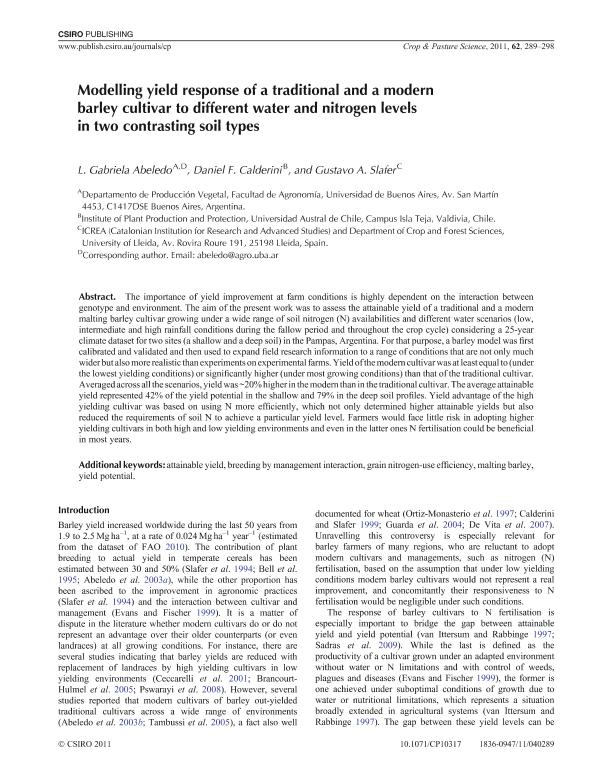Mostrar el registro sencillo del ítem
dc.contributor.author
Abeledo, Leonor Gabriela

dc.contributor.author
Calderini, Daniel F.
dc.contributor.author
Slafer, Gustavo A.
dc.date.available
2017-04-25T19:36:37Z
dc.date.issued
2011-02
dc.identifier.citation
Abeledo, Leonor Gabriela; Calderini, Daniel F.; Slafer, Gustavo A.; Modelling yield response of a traditional and a modern barley cultivar to different water and nitrogen levels in two contrasting soil types; Csiro Publishing; Crop & Pasture Science; 62; 4; 2-2011; 289-298
dc.identifier.issn
1836-5795
dc.identifier.uri
http://hdl.handle.net/11336/15724
dc.description.abstract
The importance of yield improvement at farm conditions is highly dependent on the interaction between genotype and environment. The aim of the present work was to assess the attainable yield of a traditional and a modern malting barley cultivar growing under a wide range of soil nitrogen (N) availabilities and different water scenarios (low, intermediate and high rainfall conditions during the fallow period and throughout the crop cycle) considering a 25-year climate dataset for two sites (a shallow and a deep soil) in the Pampas, Argentina. For that purpose, a barley model was first calibrated and validated and then used to expand field research information to a range of conditions that are not only much wider but also more realistic than experiments on experimental farms. Yield of the modern cultivar was at least equal to (under the lowest yielding conditions) or significantly higher (under most growing conditions) than that of the traditional cultivar. Averaged across all the scenarios, yield was ~20% higher in the modern than in the traditional cultivar. The average attainable yield represented 42% of the yield potential in the shallow and 79% in the deep soil profiles. Yield advantage of the high yielding cultivar was based on using N more efficiently, which not only determined higher attainable yields but also reduced the requirements of soil N to achieve a particular yield level. Farmers would face little risk in adopting higher yielding cultivars in both high and low yielding environments and even in the latter ones N fertilisation could be beneficial in most years.
dc.format
application/pdf
dc.language.iso
eng
dc.publisher
Csiro Publishing

dc.rights
info:eu-repo/semantics/openAccess
dc.rights.uri
https://creativecommons.org/licenses/by-nc-sa/2.5/ar/
dc.subject
Attainable Yield
dc.subject
Breeding by Management Interaction
dc.subject
Grain Nitrogen-Use Efficiency
dc.subject
Malting Barley
dc.subject.classification
Agricultura

dc.subject.classification
Agricultura, Silvicultura y Pesca

dc.subject.classification
CIENCIAS AGRÍCOLAS

dc.title
Modelling yield response of a traditional and a modern barley cultivar to different water and nitrogen levels in two contrasting soil types
dc.type
info:eu-repo/semantics/article
dc.type
info:ar-repo/semantics/artículo
dc.type
info:eu-repo/semantics/publishedVersion
dc.date.updated
2017-04-24T20:41:59Z
dc.journal.volume
62
dc.journal.number
4
dc.journal.pagination
289-298
dc.journal.pais
Australia

dc.journal.ciudad
Collingwood
dc.description.fil
Fil: Abeledo, Leonor Gabriela. Universidad de Buenos Aires. Facultad de Agronomía. Departamento de Producción Vegetal. Cátedra de Cerealicultura; Argentina. Consejo Nacional de Investigaciones Científicas y Técnicas. Oficina de Coordinación Administrativa Parque Centenario; Argentina
dc.description.fil
Fil: Calderini, Daniel F.. Universidad Austral de Chile; Chile
dc.description.fil
Fil: Slafer, Gustavo A.. Universitat de Leida; España
dc.journal.title
Crop & Pasture Science

dc.relation.alternativeid
info:eu-repo/semantics/altIdentifier/url/http://www.publish.csiro.au/cp/CP10317
dc.relation.alternativeid
info:eu-repo/semantics/altIdentifier/doi/http://dx.doi.org/10.1071/CP10317
Archivos asociados
